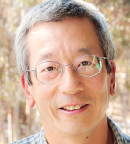
Our work is often described as building and training molecular spies—molecules that will enter a cell or organism and report back to us what the conditions are, what’s going on with the biochemistry, while the cell is still alive.— Roger Y. Tsien, PhD
Tweet this quote
In 2008, Roger Y. Tsien, PhD, shared the Nobel Prize in chemistry with Drs. Osamu Shimomura and Martin Chalfie for helping turn green fluorescent protein from a jellyfish into a research tool that could tag cancer cells or track the advance of Alzheimer’s disease. “Our work is often described as building and training molecular spies—molecules that will enter a cell or organism and report back to us what the conditions are, what’s going on with the biochemistry, while the cell is still alive,” Dr. Tsien said during an interview. Dr. Tsien died on August 24 in Eugene, Oregon. He was 64.
A Precocious Child
Dr. Tsien was a precocious child who suffered from asthma, spending a lot of time indoors conducting experiments in his makeshift basement laboratory. A notebook he kept as an 8-year-old is now a part of the Nobel Museum in Stockholm, Sweden. He used the notebook to write his chemistry experiements. When he was 16, Dr. Tsien won first prize in the Westinghouse Talent Search with a project investigating how metals bind to thiocyanate.
After high school, Dr. Tsien attended Harvard College on a National Merit Scholarship. He graduated summa cum laude with a degree in chemistry and physics in 1972. Dr. Tsien then earned a doctorate in physiology from the University of Cambridge, where he was a research fellow for a few years before joining the University of California (UC), Berkeley, and then UC San Diego, where his groundbreaking research truly accelerated.
‘A Soaring Spirit’
Dr. Tsien was a member of the Institute of Medicine, the American Academy of Arts and Sciences, the U.S. National Academy of Sciences, and the Royal Society of London. He was the recipient of numerous awards, including the Gairdner Foundation International Award, the American Chemical Society Award for Creative Invention, the Heineken Prize for Biochemistry and Biophysics, the Max Delbruck Medal in Molecular Medicine, the Wolf Prize, and the Keio Medical Science Prize.
Noted for his humility, Dr. Tsien once remarked, “My interest in imaging with multiple glowing colors … reflects visual interests from early childhood, which I have been lucky enough to align with a professional career. From a strictly biological point of view, my contributions have mainly been in the development of techniques. Man-made techniques do have a habit of becoming obsolete, whereas basic discoveries about how nature works, like those of Darwin and Watson and Crick, should last forever.”
Dr. Tsien’s wife, Wendy, said of her late husband, “He was ever the adventurer, the pathfinder, the free and soaring spirit. Courage, determination, creativity, and resourcefulness were hallmarks of his character. He accomplished much. He will not be forgotten.” ■

